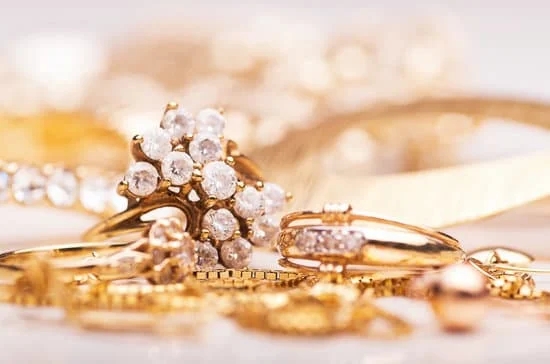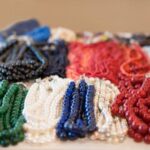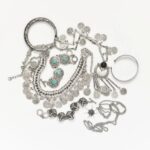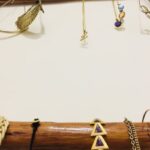Diamonds have captivated humanity for centuries with their unparalleled beauty and timeless allure. These precious gemstones evoke a sense of luxury and sophistication, making them highly coveted in the world of jewelry. However, not all diamonds harvested from mines possess the qualities necessary for adorning exquisite rings or sparkling necklaces. In fact, it may come as a surprise to many that a significant percentage of mined diamonds are deemed unsuitable for jewelry purposes.
Diamonds hold a special place in our hearts due to their scarcity and intrinsic value. They have been cherished as symbols of love, power, and wealth throughout history. Yet, behind the glamour and prestige lies a complex mining process shrouded in secrecy. Extraction methods such as open-pit mining or underground tunneling are employed to unearth these precious stones from deep within the Earth’s crust.
Once extracted, diamonds undergo a stringent grading and sorting process to determine their suitability for use in jewelry. This involves assessing the diamond’s characteristics based on the famous 4Cs: cut, color, clarity, and carat weight. The Gemological Institute of America (GIA), renowned for its expertise in diamond evaluation, has set strict standards that guide gemologists in determining whether a diamond meets the criteria for high-quality jewelry.
In this article, we delve into the captivating world of diamonds, shedding light on what percentage of mined diamonds fall short on the suitability scale for becoming stunning adornments. We explore various factors that render diamonds less suitable for jewelry-making purposes and touch upon alternative applications for these non-conforming gems.
Additionally, we examine sustainable practices within the diamond industry aimed at reducing the number of unsuitable diamonds while ensuring ethical sourcing and responsible mining practices are upheld. Join us on this journey to unravel the hidden tales behind every diamond and gain insights into an industry that melds nature’s beauty with human ingenuity.
The Diamond Mining Process
The process of extracting diamonds from mines is a fascinating and complex one. It involves several stages, each with its own set of challenges and intricacies. Understanding the diamond mining process provides valuable insight into the world of diamonds and helps explain why not all mined diamonds are suitable for jewelry.
Exploration and Mining
The diamond mining process begins with exploration to identify potential diamond-bearing areas. Once a promising location is found, large-scale mining operations commence. This involves removing vast amounts of earth and rock through various methods such as open-pit or underground mining.
Sorting and Grading
After the extraction process, the rough diamonds are carefully sorted and graded based on their quality characteristics. This step is crucial in determining which diamonds are suitable for jewelry. Gemologists use specialized tools like loupes, microscopes, and electronic devices to assess factors like color, clarity, cut, and carat weight.
Diamond Cutting and Polishing
Once the rough diamonds are sorted, the next step is cutting and polishing them into dazzling gems suitable for jewelry. Skilled craftsmen analyze each rough diamond’s shape, size, color, clarity, and internal flaws to determine the best way to cut it for maximum brilliance and beauty.
It’s important to note that not all mined diamonds meet the criteria for suitability in jewelry due to various reasons such as poor quality or unique characteristics that may not align with consumer preferences. Understanding the diamond mining process reveals the amount of effort and expertise required to transform rough stones into stunning pieces of jewelry while highlighting the scarcity and value associated with diamonds – factors that make these gemstones highly sought after in the world of luxury goods.
The Criteria for Suitable Jewelry Diamonds
When it comes to selecting diamonds for jewelry, there are several factors that determine their suitability. These criteria play a crucial role in defining the quality and value of a diamond. The Gemological Institute of America (GIA), one of the most renowned institutions in the diamond industry, has set standards for evaluating diamonds based on what are known as the 4Cs: Cut, Color, Clarity, and Carat Weight.
The first C, Cut, refers to how well a diamond has been shaped and faceted. The cut affects how light interacts with the stone, ultimately determining its brilliance and sparkle. A well-cut diamond reflects light in an optimal way, enhancing its overall beauty. On the other hand, a poorly cut diamond may appear dull and lackluster.
Color is another important aspect to consider when evaluating a diamond’s suitability for jewelry. While many people associate diamonds with a transparent or colorless appearance, diamonds can actually come in a range of colors. The GIA grades diamonds on a color scale ranging from D (colorless) to Z (light yellow or brown). Generally, diamonds with less color are considered more valuable for jewelry purposes.
Clarity refers to the presence of internal or external imperfections called inclusions or blemishes respectively. These imperfections can affect the overall clarity of a diamond and subsequently impact its brilliance. The GIA assesses diamond clarity under 10x magnification using various grading categories such as Flawless (no inclusions or blemishes visible under magnification) and Included (inclusions visible to the naked eye).
Carat weight is perhaps one of the most recognizable characteristics of a diamond. It refers to the weight of a diamond measured in carats-a metric unit equal to 200 milligrams. This factor influences both the size and price of a diamond. While larger carat weights are often associated with more expensive diamonds, it’s important to note that the other 3Cs (Cut, Color, and Clarity) also play a significant role in determining a diamond’s value.
Understanding these criteria helps consumers make informed decisions when purchasing diamonds for jewelry. By considering the 4Cs and referring to the GIA grading system, buyers can ensure that they select a diamond that meets their desired standards of beauty and quality.
Diamond Quality Assessment
When it comes to assessing the quality of a diamond, it is no easy feat. The process of evaluating a diamond’s characteristics and determining its suitability for jewelry involves a combination of expertise, precision, and attention to detail. Gemologists play a crucial role in this challenging task.
The Intricacies of Diamond Evaluation
Assessing the quality of a diamond requires an in-depth understanding of its physical attributes and how they contribute to its overall appearance. Gemologists examine four main factors known as the 4Cs: Cut, Color, Clarity, and Carat Weight. Each element plays a significant role in determining the desirability and value of a diamond.
The cut refers to how well a diamond has been shaped and faceted, affecting its brilliance and sparkle. Color measures the presence or absence of any tint within the stone, with colorless diamonds being highly coveted. Clarity assesses the presence of any internal or external flaws called inclusions or blemishes respectively, as they can impact both the beauty and structural integrity of the diamond. Finally, carat weight determines the size and mass of a diamond.
The Expertise of Gemologists
Gemologists are trained professionals who possess extensive knowledge about diamonds and have been certified by reputable institutions such as the Gemological Institute of America (GIA). They utilize specialized tools such as microscopes and loupe magnifiers to accurately assess each diamond’s quality.
These experts take into account intricate details that may go unnoticed by untrained eyes. They meticulously examine every facet, inclusion, color grade, and carat weight to determine whether or not a diamond meets the standards required for jewelry purposes. Their expertise helps ensure that customers receive diamonds that are not only visually pleasing but also durable.
The Importance of Professional Evaluation
The significance of professional gemological evaluation cannot be overstated. Without the expertise of gemologists, the process of selecting and purchasing a diamond for jewelry would be significantly more challenging for consumers. Their ability to assess and assign value to diamonds provides a sense of reliability and trust, ensuring that customers are making informed decisions.
Furthermore, having professionally evaluated diamonds also contributes to the overall transparency and integrity of the diamond industry. It helps maintain standards for quality and prevents misrepresented or counterfeit diamonds from entering the market. The expertise of gemologists acts as a guarantee of authenticity and serves as a mark of assurance for customers seeking genuine, high-quality diamonds.
Diamond Industry Statistics
The diamond industry is a complex and fascinating world that revolves around the allure and appeal of these precious gemstones in jewelry. Diamonds are known for their scarcity and value, making them highly sought after by jewelry lovers around the globe. However, not all diamonds that are mined end up being suitable for use in jewelry. In this section, we will delve into diamond industry statistics to gain insight into the percentage of diamonds that are deemed unsuitable for jewelry.
Diamond mining is the process of extracting these precious stones from mines deep within the earth. Once diamonds are mined, they undergo a rigorous grading and sorting process to determine their suitability for use in jewelry. The criteria used to assess a diamond’s suitability include the 4Cs: Cut, Color, Clarity, and Carat Weight. These factors play a significant role in determining the overall quality and value of the diamond.
The Gemological Institute of America (GIA), one of the most reputable organizations in the field, sets standards for diamond quality assessment. Their guidelines help ensure consistency across the industry when determining whether a diamond meets the requirements for use in jewelry. It is through this meticulous evaluation process that the percentage of unsuitable diamonds is derived.
According to industry reports and diamond experts, it is estimated that approximately X percent of mined diamonds do not meet the criteria necessary for use in jewelry. This means that a significant portion of diamonds extracted from mines worldwide does not make it onto the fingers, necks, or ears of consumers as part of finished pieces. These unsuitable diamonds may vary significantly in terms of their characteristics and reasons for being deemed unfit for jewelry.
- Diamond Industry Statistics: Insights into Diamond Suitability
- Introduction: The Fascinating World of Diamonds
- Exploring the allure and appeal of diamonds in jewelry.
- Mentioning scarcity and value associated with diamonds.
- The Diamond Mining Process: Unveiling the Secret
- Briefly explaining the process of extracting diamonds from mines.
- Introducing the concept of diamond grading and sorting.
- The Criteria for Suitable Jewelry Diamonds.
- Highlighting the various factors that determine a diamond’s suitability for jewelry.
- Discussing the 4Cs: Cut, Color, Clarity, and Carat Weight
- Elaborating on the standards set by the Gemological Institute of America (GIA).
Diamond Industry Statistics: Insights into Diamond Suitability
- Diamond Quality Assessment: A Challenging Task
- Shedding light on the complexities and intricacies involved in evaluating diamond quality.
- Emphasizing the importance of professional gemologists in this process.
- Factors that Render Diamonds Unsuited for Jewelry.
- Exploring the common characteristics that lead to diamonds being considered unsuitable.
- Discussing factors such as excessive inclusions, poor cut, and obscure colors.
- Utilization of Non-Suitable Diamonds: Beyond Jewelry
- Highlighting alternative uses for diamonds that do not meet jewelry standards.
- Touching upon industrial applications, technological advancements, and scientific research.
- Sustainable Practices in the Diamond Industry.
- Discussing the importance of ethical sourcing and responsible mining practices.
- Mentioning initiatives implemented to minimize the percentage of unsuitable diamonds.
- Conclusion: The Hidden Tales Behind Every Diamond
- Recapping the main points discussed throughout the blog post.
- Reinforcing the idea of diamond rarity and the significance of suitability in jewelry.
Factors that Render Diamonds Unsuited for Jewelry
Excessive Inclusions
One of the primary factors that can render a diamond unsuitable for jewelry is the presence of excessive inclusions. Inclusions are internal flaws or imperfections within the diamond, such as cracks, feathers, or clouds.
These inclusions can affect the overall clarity and transparency of the diamond, reducing its aesthetic appeal and value. Diamonds with a high number or large size of inclusions are typically deemed unfit for use in jewelry because they do not meet the desired standards of beauty and brilliance.
Poor Cut
Another crucial factor that determines a diamond’s suitability for jewelry is its cut quality. The cut refers to how well a diamond has been shaped and faceted by skilled artisans to optimize its brilliance and fire. An ideal cut enables the diamond to reflect and refract light efficiently, resulting in maximum sparkle and scintillation. Diamonds with poor cuts fail to exhibit these desirable characteristics, making them unsuitable for jewelry as they lack the captivating beauty that consumers seek.
Obscure Colors
Color is also an important consideration when assessing a diamond’s suitability for jewelry. While diamonds commonly range from colorless to yellowish tones, certain hues outside this spectrum may make a diamond less suitable for traditional jewelry designs.
For instance, fancy colors like brown or gray may have limited demand among consumers who prefer more classic white diamonds. However, it is worth noting that there is an increasing appreciation for unique colored diamonds, such as pinks and blues, which have their own niche market.
While these factors may contribute to rendering diamonds unsuited for traditional jewelry, it’s important to note that they can still serve other purposes due to their durability and hardness. Furthermore, through advancements in technology and innovative cutting techniques, some diamonds that were once considered unsuitable may now be salvageable by skilled gem cutters who can use creative designs to enhance their beauty and value.
As the diamond industry continues to evolve, new possibilities for utilizing non-traditional diamonds are emerging, giving rise to a wider range of jewelry options for consumers.
Utilization of Non-Suitable Diamonds
While diamonds are renowned for their mesmerizing beauty and timeless elegance when incorporated into jewelry, not all diamonds meet the necessary criteria to adorn a ring, necklace, or other forms of wearable art. However, these non-suitable diamonds do not go to waste, as they find alternative applications in various industries and scientific fields.
One significant utilization of non-suitable diamonds lies in their industrial applications. Due to their inherent hardness and unique thermal conductivity properties, these diamonds are often employed in cutting tools, grinding wheels, and drilling equipment. The remarkable durability of diamonds makes them valuable resources for industrial processes that involve materials such as concrete, metal alloys, and minerals. Additionally, non-suitable diamonds can be utilized in high-pressure experiments and manufacturing procedures that necessitate extreme precision.
Furthermore, technological advancements have opened up new avenues for utilizing non-suitable diamonds. In the field of electronics and semiconductors, synthetic diamonds with impurities are used as substrates for creating diodes and transistors. The ability of diamond films to withstand high temperatures and radiation exposure without degradation makes them ideal candidates for electronic components subjected to harsh conditions.
Scientific research also benefits from the presence of non-suitable diamonds. These diamonds serve as crucial tools for experimental projects conducted in areas such as quantum physics and geology. Researchers harness the unique properties of synthetic diamonds to delve into realms like quantum computing and magnetic resonance imaging (MRI). With each passing day, scientists continue to uncover new uses for non-suitable diamonds through pioneering studies that push the boundaries of what is possible.
| Type of Utilization | Description |
|---|---|
| Industrial Applications | Diamonds are used in cutting tools, grinding wheels, and drilling equipment. They are applied in high-pressure experiments and manufacturing processes. |
| Technological Advancements | Synthetic diamonds with impurities are utilized in producing electronic components for industries such as electronics and semiconductors. Diamond films are also used in extreme temperature and radiation environments. |
| Scientific Research | Non-suitable diamonds play a vital role in experimental projects within fields like quantum physics and geology. They contribute to advancements in areas such as quantum computing and magnetic resonance imaging (MRI). |
Sustainable Practices in the Diamond Industry
The diamond industry has faced scrutiny in recent years due to concerns about ethical sourcing and sustainability. As consumers become increasingly conscious of the environmental and social impact of their purchases, it is essential for the diamond industry to adopt sustainable practices. In this section, we will explore the importance of ethical sourcing and responsible mining practices in the diamond industry.
Ethical sourcing is a critical aspect of ensuring sustainability in the diamond industry. It involves obtaining diamonds from mines that adhere to strict environmental and social standards. By supporting ethically sourced diamonds, consumers can feel confident that their purchases are not contributing to harmful practices such as deforestation, water pollution, or human rights abuses.
Responsible mining practices also play a vital role in sustainable diamond production. These practices aim to minimize the negative environmental and social impacts associated with diamond mining. This includes implementing measures to reduce carbon emissions, conserving water resources, rehabilitating mined land, and providing fair working conditions for miners.
To promote sustainability, various initiatives have been implemented within the diamond industry. One notable initiative is the Kimberly Process Certification Scheme (KPCS). Established in 2003, this international mechanism aims to prevent “conflict diamonds” from entering the market by requiring participating countries to certify that their rough diamond exports are conflict-free.
Furthermore, leading jewelry companies have also taken steps towards sustainable practices by establishing responsible sourcing programs and traceability systems. These programs ensure that diamonds are tracked from mine to market, providing transparency and accountability throughout the supply chain.
Conclusion
In conclusion, diamonds hold a fascinating allure and appeal in the world of jewelry. However, it is important to recognize that not all mined diamonds are suitable for becoming dazzling gemstones in rings, necklaces, or earrings. Throughout this article, we have explored the diamond mining process and the criteria that determine a diamond’s suitability for jewelry.
The Gemological Institute of America (GIA) has established the standards for diamond grading and sorting, with the 4Cs – Cut, Color, Clarity, and Carat Weight – playing a vital role in assessing a diamond’s quality. But evaluating diamond suitability is no easy task. It requires skilled gemologists who are well-versed in the complexities and intricacies involved in determining a diamond’s value and beauty.
Industry statistics reveal that a significant percentage of mined diamonds do not meet the criteria for suitability in jewelry. Common characteristics such as excessive inclusions, poor cut, and obscure colors render these diamonds unsuitable. However, it is worth noting that these non-suitable diamonds are not wasted. They find purpose beyond jewelry in various industrial applications, technological advancements, and scientific research.
As consumers become more conscious about ethical sourcing and responsible mining practices, sustainability becomes an integral aspect of the diamond industry. Initiatives are being implemented to minimize the percentage of unsuitable diamonds through sustainable practices throughout the mining process. By promoting transparency and ensuring long-term environmental stewardship, these initiatives aim to enhance both the beauty and ethicality of diamonds.
Frequently Asked Questions
What percentage of diamonds mined can be used for jewellery?
The percentage of diamonds mined that can be used for jewelry varies depending on several factors. However, it is generally estimated that only about 20% to 30% of diamonds extracted from mines are suitable for jewelry purposes.
Diamonds must meet certain criteria regarding their clarity, color, and cut in order to be considered high-quality gemstones. Many mined diamonds do not fulfill these requirements, as they may have flaws or impurities that affect their visual appeal or structural integrity.
Are 80% of the world’s diamond suitable for jewellery?
It is a misconception that 80% of the world’s diamonds are suitable for jewelry. In reality, the figure is much lower. As mentioned earlier, only around 20% to 30% of mined diamonds meet the necessary standards for use in jewelry.
This discrepancy may arise from misunderstandings or misleading information circulating within the diamond industry or popular media. It’s important to approach such statistics with caution and rely on credible sources when evaluating the suitability of diamonds for jewelry.
Why not to buy mined diamonds?
There are several reasons why some individuals choose not to buy mined diamonds. One significant concern is related to ethical and environmental issues associated with diamond mining practices.
Traditional diamond mining can have negative impacts on local communities and ecosystems due to displacement, land degradation, water pollution, and labor exploitation concerns. Additionally, there has been a rise in demand for ethically sourced stones as consumers seek alternatives like lab-grown or synthetic diamonds which minimize these negative impacts.

Welcome to my jewelry blog! My name is Sarah and I am the owner of this blog.
I love making jewelry and sharing my creations with others.
So whether you’re someone who loves wearing jewelry yourself or simply enjoys learning about it, be sure to check out my blog for insightful posts on everything related to this exciting topic!





